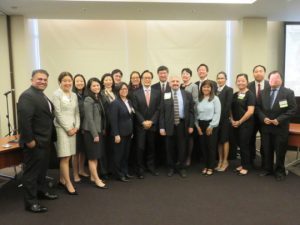Oyama v. California
In 1948 the Supreme Court explored the ways in which denial of property rights also served to promote racial discrimination against the Japanese in California.
Inspired by Prof. Rose Cuison Villazor’s law review article, “Rediscovering Oyama v. California: At the Intersection of Property, Race, and Citizenship,” 87 Wash. U. L. Rev. 979 (2010), the reenactment dealt with the California Alien Land Law which prevented “aliens ineligible from citizenship” – i.e., Japanese – from owning land. The case explored the ways in which denial of property rights also served to promote racial discrimination against the Japanese in California. In the case, Kajiro Oyama, a Japanese immigrant who was ineligible for United States citizenship at the time, bought a parcel of farm land which he deeded to his minor son Fred, who was born in the United States and was thus a citizen. Under the Alien Land Laws, this transaction was deemed a fraud and the State of California brought suit against Fred Oyama to escheat the property. The case went all the way up to the United States Supreme Court, where the statute’s constitutionality was placed before the Court for its review.
Using actual trial transcripts and a reconstruction of the argument before the United States Supreme Court, illustrated with photos from the time, this reenactment brought back to life an important but nearly forgotten case in the annals of the civil rights struggle in the United States and the part played by Asian Americans in that movement. The doctrines and alliances formed in litigating the Oyama case laid the groundwork for later cases that dealt with equal rights and equal treatment under the law, including Brown v. Board of Education.
AABANY gratefully acknowledges the assistance and support of David Weinberg and the Jurygroup for creating the PowerPoint slides that accompanied this reenactment
SCRIPT EXCERPT:
NARRATOR 2: Asians began immigrating to the United States in significant numbers in the mid-19th century, when the Gold Rush drew Chinese to California. They quickly became a source of cheap labor, generating resentment on the part of organized labor in particular. Politicians capitalized on anti-Asian sentiment, and the press fanned the flames by publishing anti-Asian stories and editorials. In 1882, the Chinese Exclusion Act was passed, and by 1920, the number of Chinese in California had dropped by more than half.
NARRATOR 1: As the number of Chinese decreased, the number of Japanese in the United States increased. When the Japanese government finally permitted its citizens to emigrate for the first time in 1880, many headed to America. The 1880 United States census counted only 148 people of Japanese descent; by 1910, the number had grown to more than 152,000. Japanese immigrants became California’s major source of agricultural labor.
NARRATOR 2: The Japanese soon encountered the same resentment previously directed toward the Chinese. In October 1906, the San Francisco Board of Education passed a resolution ordering segregation of Japanese and Chinese pupils in public schools. This local act became an international incident when the Japanese government protested to President Theodore Roosevelt, who denounced the measure in his December 4, 1906 message to Congress.
PERFORMANCES BY AABANY

On Friday, November 4, 2016, the AABANY Trial Reenactment team presented at the NAPABA National Convention its tenth reenactment, “This Land is Our Land: Oyama v. California” at the Hilton San Diego Bayfront. In the cast for this premiere performance of “This Land is Our Land: Oyama v. California” were Vincent T. Chang, Yang Chen, Theodore K. Cheng, Francis H. Chin, Andrew T. Hahn, Lauren U.Y. Lee, Linda S. Lin, Kiyo A. Matsumoto, Concepcion A. Montoya, Clara J. Ohr, Vinoo Varghese, Ona T. Wang, and Jessica Wong.
Once again, Hon. Denny Chin, United States Court of Appeals, Second Circuit, and Kathy Hirata Chin, (now Partner, Crowell & Moring), led the AABANY Trial Reenactment Team in pulling together the record and historical background to produce yet another compelling script to recount an all but forgotten yet no less significant episode in Asian American history that played a vital part in America’s civil rights struggle.
[slideshow_deploy id=’1558′]
Allen & Overy, New York, NY, May 24, 2023
Cadwalader, Wickersham & Taft LLP, New York, NY, May 13, 2017
NAPABA National Convention, San Diego, CA, November 4, 2016
PERFORMANCES BY OTHER ORGANIZATIONS
APALSA, University of California at Davis School of Law, Davis, CA, February 20, 2018
